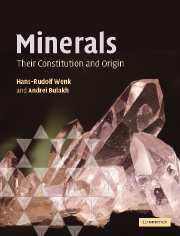Book contents
- Frontmatter
- Contents
- Preface
- Acknowledgments
- Figure credits
- Part I Structural features of minerals
- 1 Subject and history of mineralogy
- 2 Elements, bonding, simple structures, and ionic radii
- 3 The concept of a lattice and description of crystal structures
- 4 Macroscopic symmetries : crystal morphology
- 5 Crystal growth and aggregation
- 6 Isomorphism, polymorphism, and crystalline defects
- Part II Physical investigation of minerals
- Part III Variety of minerals and mineral-forming processes
- Part IV A systematic look at mineral groups
- Part V Applied mineralogy
- Appendices
- Glossary
- References
- Index
- Plate section
- References
4 - Macroscopic symmetries : crystal morphology
from Part I - Structural features of minerals
- Frontmatter
- Contents
- Preface
- Acknowledgments
- Figure credits
- Part I Structural features of minerals
- 1 Subject and history of mineralogy
- 2 Elements, bonding, simple structures, and ionic radii
- 3 The concept of a lattice and description of crystal structures
- 4 Macroscopic symmetries : crystal morphology
- 5 Crystal growth and aggregation
- 6 Isomorphism, polymorphism, and crystalline defects
- Part II Physical investigation of minerals
- Part III Variety of minerals and mineral-forming processes
- Part IV A systematic look at mineral groups
- Part V Applied mineralogy
- Appendices
- Glossary
- References
- Index
- Plate section
- References
Summary
Introduction
In the previous chapters we have become familiar with the extraordinary regularity of the internal structure of crystals. The local balancing of bonding forces between atoms leads to a periodic repetition of elementary units. We have seen that these unit cells and the corresponding lattice arrays are diagnostic for specific minerals and have classified them according to their symmetry. Symmetry emerged as a central feature of minerals and crystals. In Chapter 3, we recognized seven crystal systems, ranging from the highest cubic symmetry to the lowest triclinic symmetry. In this chapter we will look at symmetry more formally, particularly in view of the possible symmetries that are present in the external morphology of crystals.
A characteristic feature of crystals is “directionality”: specific directions in crystals are inherently different, and these differences are implicit in the lattice structure. Take, for example, a cubic crystal of galena (Figure 4.1a, e): if we view it along a crystal axis (e.g. [100]), we observe a 4-fold symmetry (Figure 4.1b); if the crystal is viewed along a body diagonal (e.g. [111]), it displays 3-fold symmetry (Figure 4.1c); if the cube is viewed along the bisectrix of two faces (e.g. [110]), two different mirror planes are observed (Figure 4.1d). If the growth velocity were isotropic, or equal in all directions, crystals would occur as spheres. Instead they display a regular morphology with planar surfaces. The largest faces are indicative of directions in which the growth velocity is slowest.
- Type
- Chapter
- Information
- MineralsTheir Constitution and Origin, pp. 54 - 83Publisher: Cambridge University PressPrint publication year: 2004



